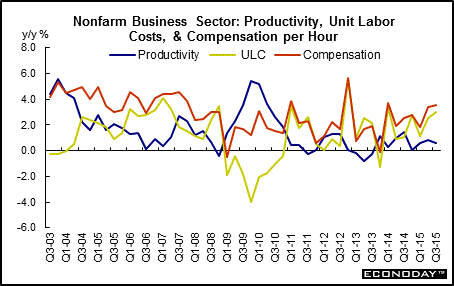
|
Long Term Perspective While accelerating wage gains could lead to consumer price increases, it is important to look at the link in between – productivity. Productivity gains allow wages to increase without generating inflationary pressures. Note how sharp productivity increases in the graph are associated with only modest gains in unit labor costs. The previous recovery had low job gains ("the jobless recovery") partly due to the sharp productivity gains in 2003 and 2004. Productivity gains were more moderate in 2005 and fell in 2006, remaining low in the first half of 2007 before turning up in 2010. While productivity growth is a good long-term factor for economic prosperity, it is not helpful to the labor market in the short run when fewer workers are necessary to get the job done. The current recovery had initially been a jobless recovery with steady job gains starting only in early 2010 (at least for the private sector). Productivity growth since 2010 has been flat.
Unit labor costs are also important for Fed officials. They tend to run inversely to productivity. That is, when productivity increases, unit labor costs decline and vice versa.
Short Term Perspective Compensation stole the headlines in the first revision to the third-quarter productivity report, up a sharp quarter-to-quarter 4.0 percent in one of the few signs of wage pressures. The rise fed a sizable 1.8 percent quarterly rise in unit labor costs. Output was moderate, also at 1.8 percent. But year-on-year data tell a more tangible story with productivity up only 0.6 percent in the third quarter vs a sizable 3.0 percent rise for labor costs. Low productivity, and together with it rising labor costs, point to the effects of full employment and limited investment in new technologies.
|
|||||||
| Legal Notices | ©Copyright 1998-2024 Econoday, Inc. |
powered by
![[Econoday]](images/logo.gif)
![[Apple App Store]](/images/AppleAppStore.png) ![[Econoday on Kindle]](/images/kindle.jpg) 
|
||||||

